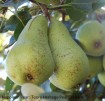Anderson’s 1880’s unknown John’s family were one of the first European settlers in San Remo and the family settled on the shores of San Remo. One of the original old pears was still on the property 10 years ago, although the homestead had long since been pulled down variety. We took scion from this tree and grafted. We are still awaiting the arrival or pears.
Beurre Bosc
Beurre Easter
Originated Belgium 1820’s. Skin is thick and somewhat tough, greenish and sometimes slightly russet-ed. Flesh slightly gritty, buttery, moderately juicy. Fairly sweet, ripens best under refrigeration. Fruits very late in season.
Grafts are quince compatible
Beurre Capiamont
 Originated in Belgium in 1787. Skin a fine clear cinnamon, fading into yellow in the shade, and acquiring a rich bright red in the sun. Flesh yellowish, melting, buttery, very rich, and highly flavoured. The Gardeners Chronicle of 1841 commented “A good quality dessert pear.”
Originated in Belgium in 1787. Skin a fine clear cinnamon, fading into yellow in the shade, and acquiring a rich bright red in the sun. Flesh yellowish, melting, buttery, very rich, and highly flavoured. The Gardeners Chronicle of 1841 commented “A good quality dessert pear.”
Grafts are quince compatible
Beurre Hardy
Originated France 1820. The fruit is a cinnamon russet with tender, sweet, juicy flesh with flavour. An early to mid season fruit with short storage capacity.
Grafts are quince compatible
Clapps Favorite
A Flemish Beauty X Williams, USA 1860. A very large yellow pear, with a red blush. Clapp’s Favorite is an early, high quality pear. An early season pear, with short storage. Trees are very hardy and vigorous
Conference
 England 1885 * Australian variety not true to type* Fruit is yellow green with slight russet. Tender, creamy white juicy flesh with sweet pleasant flavour. Fruit is mid to late season with long storage 7 to 8 months. Grafts are quince compatible
England 1885 * Australian variety not true to type* Fruit is yellow green with slight russet. Tender, creamy white juicy flesh with sweet pleasant flavour. Fruit is mid to late season with long storage 7 to 8 months. Grafts are quince compatible
Corella
 Probably a seedling of Forelle, Australia. The skin is greeny yellow base with red over half the surface or more. Tender soft white flesh, juicy with some flavour. A late season harvest with a heavy yield and long storage
Probably a seedling of Forelle, Australia. The skin is greeny yellow base with red over half the surface or more. Tender soft white flesh, juicy with some flavour. A late season harvest with a heavy yield and long storage
Dorset
Doyene Boussoch
Originated Belgium 1836 Doyenne Boussoch is attractive looking rather round pear. Very crisp and juicy with a pleasant slightly acid flavour. A mid season fruit.
Doyenne Du Comice
Originated France 1849. Skin is greenish yellow with brownish red blush and russet around stem and eye. Pale yellow flesh, extremely melting and delicate, juicy with rich flavour. A top eating pear. Late season fruit with good storage up to 6 months. Grafts are quince compatible
Dr Jules Guyot
Originated Belgium 1870. Skin is yellow with pinkish red blush with some russet dots. Flesh is, tender, melting very juicy with a slightly musk flavour. Early season fruit with a short storage.
Eldarado
Chance seedling probably Winter Nelis X Williams USA 1945. Skin greenish yellow with very little russet. Free of blemish. Moderately firm, juicy fine textured melting flesh with very good flavour. Late season harvest with good storage.
Flemish Beauty
With smooth green skins flushed with red and a classic pear shape. The flesh is very white and fairly dense, with a typical stony pear texture.
Grosse Louise
Originated in France in the early 1800’s. A large fruit with greenish yellow skin, bruises easily. Skin is white, fine,melting and very juicy. Fairly early in season
Harrow’s Delight
Originated Canada seedling from Bartlett x Purdue. Fruit color is greenish-yellow with a red blush. Because it tends to drop heavily as it matures, fruit should be picked while still green. If left on the tree until the background colour changes to yellow, shelf life is also greatly reduced. Buttery and very juicy flesh with a good flavour. Very productive, early season fruit with short storage life. Grafts are quince compatible
Josephine De Malines
Chance seedling , Belguium 1830. A greeny/yellow pear with slight russet. Fine-grained, high quality flesh, juicy excellent flavour. A late season harvest with good storage capability
Keiffer (Culinary Pear)
 Originated USA 1863 and first sand pear to assume importance.(Sand Pear X Bartlett) Skin greenish-yellow often blushed dull red numerous large russet dots. Flesh gritty, fairly juicy tender but not fully buttery. Dual purpose pear, good as culinary pear. Grafts are quince compatible
Originated USA 1863 and first sand pear to assume importance.(Sand Pear X Bartlett) Skin greenish-yellow often blushed dull red numerous large russet dots. Flesh gritty, fairly juicy tender but not fully buttery. Dual purpose pear, good as culinary pear. Grafts are quince compatible
Lang
Lawrence
Originated USA 1843. Fruit is medium or small in size greenish-yellow in colour with dark green dots, sometimes blushed. Flesh is white, medium fine, juicy, tender but not melting, gritty at the core. Grafts are quince compatible
Napolean
 Originated Belgium 1816. The skin smooth, greenish-yellow, covered with numerous brown dots. Flesh white, tender, melting, and very juicy, with a rich, sugary, and refreshing flavour.
Originated Belgium 1816. The skin smooth, greenish-yellow, covered with numerous brown dots. Flesh white, tender, melting, and very juicy, with a rich, sugary, and refreshing flavour.
Grafts are quince compatible
Packhams Triumph
 Originated Australia NSW, 1896. Bright yellow skin with some fine russet, sometimes bumpy. Flesh is white, melting and juicy. Mid season harvest, late Feb-early March. May need thinning to get good sized fruit. Has long storage capacity 7 to 9 months.
Originated Australia NSW, 1896. Bright yellow skin with some fine russet, sometimes bumpy. Flesh is white, melting and juicy. Mid season harvest, late Feb-early March. May need thinning to get good sized fruit. Has long storage capacity 7 to 9 months.
Red Williams
Originated Australia, Burwood Victoria 1930’s. Similar to Williams but with bright red flesh. Early fruit and short storage.
Grafts are quince compatible
Vicar of Winkfield (Culinary Pear)
 This variety originated in France in 1760 and was introduced to England in 1800’s. The skin is smooth greenish-yellow with a faint tinge of red on sun-side. The flesh, white fine grained, half-melting, juicy and sweet with a musky aroma. Also valued as a fine cooking pear.
This variety originated in France in 1760 and was introduced to England in 1800’s. The skin is smooth greenish-yellow with a faint tinge of red on sun-side. The flesh, white fine grained, half-melting, juicy and sweet with a musky aroma. Also valued as a fine cooking pear.
Grafts are quince compatible
Williams Bon Chretien
Originated England 1770. Skin is golden yellow with some russet, flesh is white, transparent, fine grained and buttery, very juicy with slight musk scent. The fruit is early season and storage is short 3 to 4 months
Grafts are quince compatible
Winter Bartlett
Uverdale’s St Germaine (Culinary Pear)
An old English cooking pear of a huge size, as you can see from the picture. Dates to 1800’s.The skin is smooth, dark green, and of a dull brown on the sunny side; but as it becomes matured it is of a red colour on a yellowish ground. The flesh is white, hard, and a little gritty near the core, with an austere astringent juice, which renders it unfit for eating raw, but it is excellent for baking and stewing.
